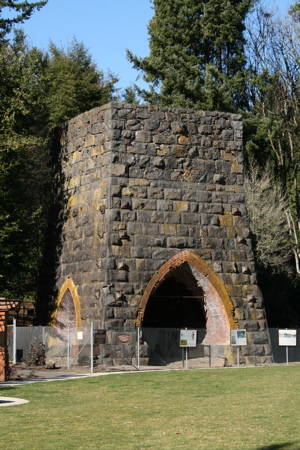 On occasion at the PropertyBlotter, we will lapse into the nostalgic and the historic.
On occasion at the PropertyBlotter, we will lapse into the nostalgic and the historic.
Today, we share a handful of myths concerning the lake, the town, founders, its early industry, and famous headstones.
(Full disclosure: I got this from the very interesting Oswego Heritage Council site).
- Oswego Lake is not an artificial lake. The natural lake was enlarged by successive dams that raised the water level and by a canal that connected it to the Tualatin River in 1873. Lakewood Bay, on the other hand, is largely man-made. It was originally a marsh, known as the Duck Pond. Developers flooded this swampy area in 1928 by digging a channel that linked it to the main lake.
- It is frequently said that Albert Alonzo Durham named Oswego after his birthplace in New York. However, Durham was born in Chenango County, not in Oswego, New York.
- The iron furnace in George Rogers Park is not a “chimney” or a “chimneystack.” This misconception probably stems from the fact that the stone tower containing the smelting chamber is called a “stack.” When it was operating, the furnace was a roaring inferno filled with burning charcoal and iron ore. A 33-foot-tall brick chimney once topped the furnace, but it was dismantled in the late 19th century. The furnace is also sometimes mistakenly called a foundry. An iron foundry re-melts pig iron and casts metal products.
- “Smelter” or “furnace” — what’s the right term? Oswego residents said “furnace” in the 19th century, which explains how Furnace Street got its name. Sometime in the early 20th century, residents began calling it a “smelter.” While this is technically correct, the term used by most historians is “furnace.” In the National Register of Historic Places the Oswego Iron Furnace is listed as the “Oregon Iron Company Furnace” after the company that built it in 1866.
- Oswego was not the first town to produce pig iron west of the Rocky Mountains. The Mormons built a small furnace at Cedar City, Utah in the 1850s. However, the 1866 Oswego Furnace was the first iron furnace on the West Coast. It was also the longest running and most productive of four furnaces built west of the Rockies in the 19th century.
- Oswego’s dream of becoming the “Pittsburgh of the West” was hardly unique. No less than eleven towns with mining or industrial ambitions aspired to this title. Among them were Kirkland, Washington; Richmond, California; Pueblo, Colorado; Eureka, Nevada; Llano, Texas; East Saint Louis, Illinois; and Terre Haute, Indiana.
- The city of Lake Oswego is not named after Oswego Lake. On the contrary, the lake is named after the town. Until 1913 the lake was called Sucker Lake. At the beginning of the 20th century developers searched for a more marketable name, at one time considering “Lake Tualatin.” In 1913 they successfully petitioned the U.S. Geographic Board to change the name to Oswego Lake. In 1960 when the city incorporated much of Lake Grove, the names of both communities were combined and the city was renamed Lake Oswego.
- Linus Pauling is not buried in the Oswego Pioneer Cemetery although there is a headstone there with his name on it. Pauling died in 1994 at his ranch in California. The family placed the headstone in the cemetery to honor his memory in the town where his relatives are buried and where he spent part of his childhood. Pauling’s grandfather was a German immigrant who came to Oregon to work in the Oswego Iron Furnace. Linus Pauling is the only winner of two unshared Nobel prizes: the prize for chemistry in 1954 and the Peace Prize in 1963.
Now, you know the rest of the story.
Source: Oswego Heritage Council. Photo courtesy of City of Lake Oswego.

 The Clackamas Indians originally inhabited the area now known as Lake Oswego. The Indians called the lake Waluga, meaning wild swan.
The Clackamas Indians originally inhabited the area now known as Lake Oswego. The Indians called the lake Waluga, meaning wild swan.